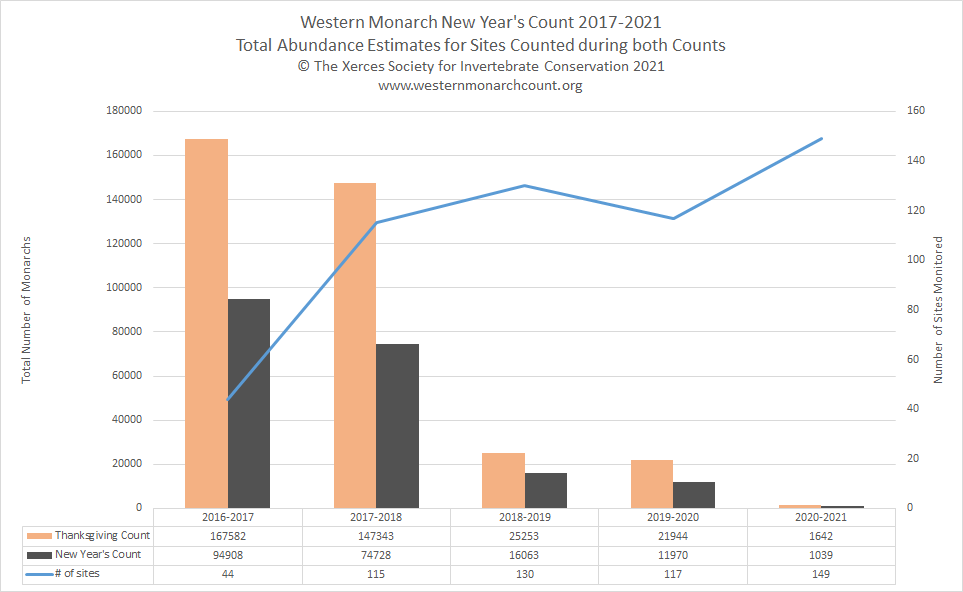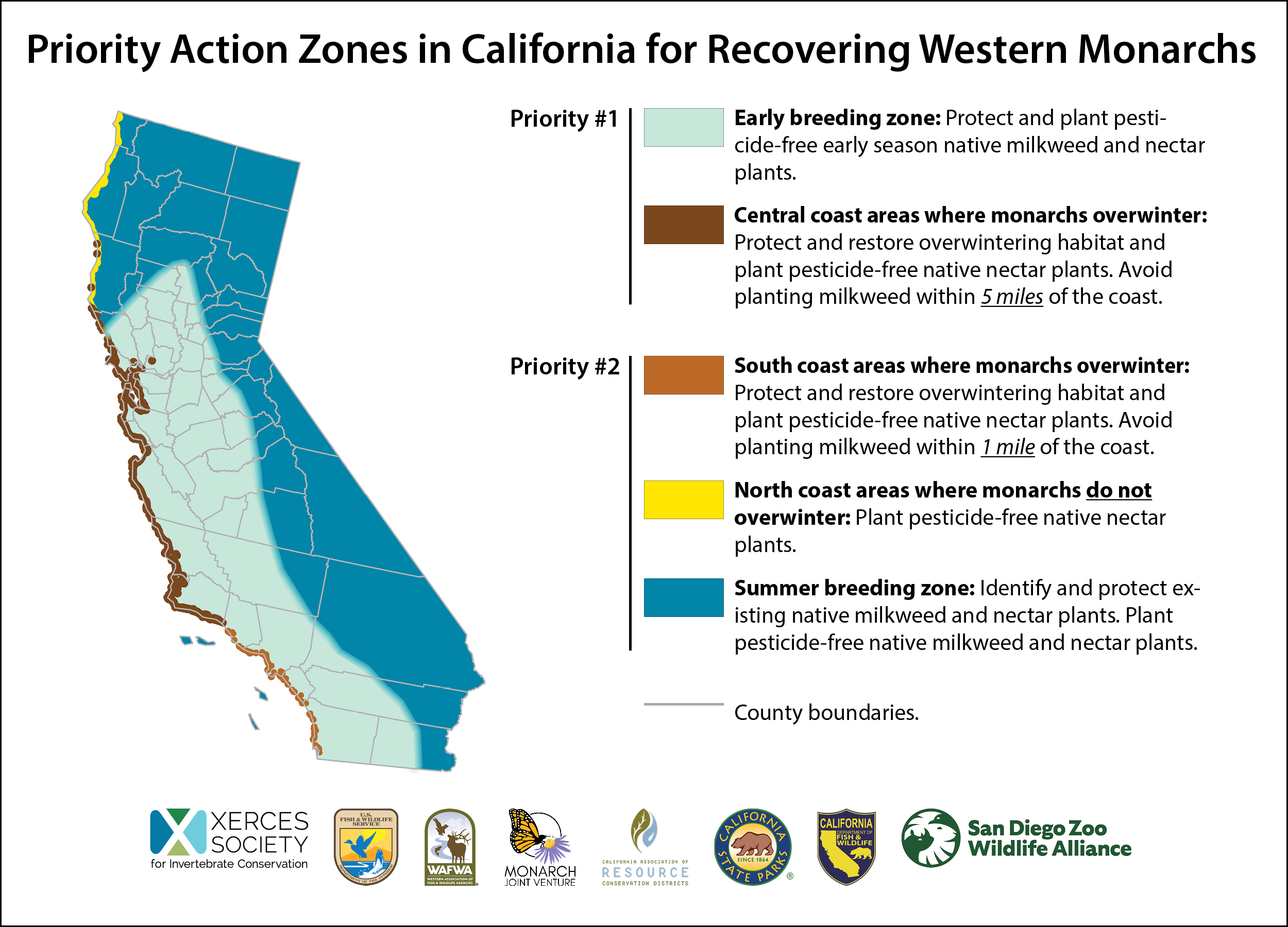Western Migratory Monarch Population Needs Extraordinary Level of Conservation to Persist.
Since 1997 volunteers have conducted counts of overwintering monarchs for the Xerces Society’s annual Western Monarch Thanksgiving Count. As a way to better understand how the overwintering population changes throughout the winter, an additional count—the New Year’s Count—was started in 2016. Now in its fifth year, the New Year’s Count has given us a better understanding of: 1) how monarch numbers may decline at overwintering sites as the winter progresses; 2) how monarchs move between and within sites; 3) when they leave sites; and 4) the level of mortality that adult monarchs may be experiencing during the winter.

Results from the Western Monarch Thanksgiving and New Year's counts. The blue line shows the number of sites visited for the New Year’s Count. Detailed data for both counts is available at westernmonarchcount.org/data/.
Between December 26, 2020, and January 10, 2021, volunteers conducted surveys for the New Year’s Count and tallied a total of 1,039 monarchs at 149 sites. These surveys followed the annual Western Monarch Thanksgiving Count, which is conducted annually for three weeks centered around the Thanksgiving holiday, and recently reported a mere 1,914 monarchs in total across 246 sites. At 77 sites, no monarchs were found during either the Thanksgiving or New Year’s Count, at 15 sites monarch numbers increased between the Thanksgiving and New Year’s counts, at 54 sites monarch numbers decreased, and at 3 sites monarch numbers stayed the same. After the dismal numbers from the Thanksgiving Count, expectations for finding monarchs were low, but the news isn’t all bad. For the sites counted during both the Thanksgiving Count and the New Year’s Count, the decline in monarchs averaged 37%, which is lower than previous years (40–49%).
Data from the New Year’s Count is crucial for developing conservation strategies for western monarchs. It allows conservation partners to prioritize efforts to restore overwintering sites and breeding habitat for the first generation that will jump-start the breeding season each year. The number of monarchs remaining at the end of the overwintering season (New Year’s Count) can give us an idea of how many monarchs will venture out into the California Coast Range and further inland to lay eggs on milkweed and start the first breeding generation in the West. Most butterflies have a 50:50 sex ratio—half the population if female, half male. Assuming half of the monarchs remaining at overwintering sites during the New Year’s Count are female, that leaves a little over 500 female monarchs capable of migrating inland to find milkweed, lay eggs, and start the first generation of the migratory population.
With so few monarchs left in California to jump-start this year’s breeding season, they need all help they can get. Efforts to improve monarch habitat in California this spring is more important than ever. Increasing both milkweed and nectar habitat within the monarch’s first stopover zone—the region where the first generation of monarchs go after leaving overwintering sites (shown in pale blue in the map below)—and protecting overwintering sites from destruction are two of the highest priority actions that can be taken. Elsewhere in California, planting habitat that can support breeding monarchs and fuel the migration are essential. The map below highlights the best actions for different parts of the state.

Priority Restoration Zones in California for recovering western monarchs. The state is divided into five zones, each with its own priority actions. [Editor's note: This map was updated on 7/29/21.]
With monarchs leaving overwintering sites, it is time to focus initially on the light blue area of the map by protecting and planting pesticide-free native milkweed and nectar plants, especially species that have resources for monarchs in February, March and April (February resources won’t help this year, but they will help next year and beyond). Based on available phenology data for native milkweed species in California, the earliest emerging milkweed species are California milkweed (Asclepias californica), heartleaf milkweed (A. cordifolia), woollypod milkweed (A. eriocarpa), and in southern California, desert milkweed (A. erosa). These early season milkweeds provide crucial breeding habitat for the first generation of monarchs born from eggs laid by the overwintering generation. Some of these early season milkweed species are not yet widely available at nurseries, but Xerces and other partners are working on increasing commercial availability of these species. Find local native milkweed and determine what nectar plants are appropriate for your region.
You can also be planting native milkweeds and nectar plants in northern and eastern areas of the California—and in the surrounding states—in readiness for when migrating monarchs reach you.
Additional Ways to Help Western Monarchs
Community Science: Please document and report all monarch activity so that researchers can get a better picture of what is happening with both the resident and migratory populations. Report all monarch sightings (adults, eggs, larvae, pupae) to the Western Monarch Milkweed Mapper. One project in particular, the Western Monarch Mystery Challenge, is a campaign running from February 14 to April 22 to collect more records of where western monarchs spend the spring in California. We know monarchs spend the winter months (November to February) in groves along the California coast, and start breeding in central California as early as February. However, we know a lot less about where they are and what they’re up to in the next couple of months. Solving the mystery of where western monarchs spend the spring is central to conserving and restoring the phenomenon of monarch migration in the West. To participate in the Western Monarch Mystery Challenge, report your monarch sightings to the Western Monarch Milkweed Mapper.
Western Monarch Call to Action: Learn about actions you can take to help save western monarchs at savewesternmonarchs.org.
Why Captive Rearing Isn’t the Way to Help Monarchs: With the reports rolling in all winter of monarchs outside overwintering sites in California, many of these butterflies were likely captive reared in homes. There are so many things that can help monarchs such as planting and improving habitat, but we do not recommend monarch rearing as a conservation strategy. Rearing a few butterflies for personal enjoyment or education is a great way to admire these impressive animals, but what monarchs really need is protected overwintering habitat and high-quality flower- and milkweed-rich habitat free from pesticides and disease. Read more about the problems with rearing monarchs in Keep Monarchs Wild: Why Captive Rearing Isn’t the Way to Help Monarchs on the Xerces blog.
Further Reading
Read the blog “Resident monarch populations on the rise in California. What does this mean for the western migratory monarch population?”.
Read the blog announcing the results from the 2020 Western Monarch Thanksgiving Count and discussing the USFWS ESA listing decision.
Learn more about the Thanksgiving and New Year’s Counts by exploring westernmonarchcount.org
Western Monarch Thanksgiving and New Year’s Count data is available online at westernmonarchcount.org/data.
Monarch Joint Venture’s Annual Research Review: A Summary of the Latest Scientific Findings About Monarch Butterflies.
Report your monarch and milkweed sightings to the Western Monarch Milkweed Mapper. This website also includes information on the biology and distribution of milkweed species as well as monarch butterfly biology in the West.



